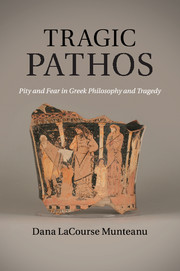Book contents
- Frontmatter
- Contents
- Preface and acknowledgments
- List of abbreviations
- Introduction
- Part i Theoretical views about pity and fear as aesthetic emotions
- Chapter 1 Drama and the emotions: an Indo-European connection?
- Chapter 2 Gorgias: a strange trio, the poetic emotions
- Chapter 3 Plato: from reality to tragedy and back
- Chapter 4 Aristotle: the first “theorist” of the aesthetic emotions
- Part ii Pity and fear within tragedies
- Appendix Catharsis and the emotions in the definition of tragedy in the Poetics
- Bibliography
- Index
Chapter 1 - Drama and the emotions: an Indo-European connection?
Published online by Cambridge University Press: 05 December 2011
- Frontmatter
- Contents
- Preface and acknowledgments
- List of abbreviations
- Introduction
- Part i Theoretical views about pity and fear as aesthetic emotions
- Chapter 1 Drama and the emotions: an Indo-European connection?
- Chapter 2 Gorgias: a strange trio, the poetic emotions
- Chapter 3 Plato: from reality to tragedy and back
- Chapter 4 Aristotle: the first “theorist” of the aesthetic emotions
- Part ii Pity and fear within tragedies
- Appendix Catharsis and the emotions in the definition of tragedy in the Poetics
- Bibliography
- Index
Summary
L’art, c'est l’émotion sans le désir.
Art is emotion without desire.
(Muriel Barbery – L’élégance du Hérisson, Paris, 2006).As dramatic representations appear to have developed from rituals in Indo-European communities, they likely required the emotional participation of those involved in ceremonies. No reconstruction of such Indo-European drama is possible, of course. Overall, nevertheless, the vocabulary of emotions in Indo-European languages suggests a common idiom, or perhaps even some universal linguistic concepts. As West has observed in an analysis of the Homeric diction:
Where human emotions are described, we find a good deal of common ground in the kind of language used in different branches of the tradition, and this may reflect to some extent Indo-European idiom. On the other hand there is little that points to its being peculiarly Indo-European and similar phraseology appears in Near Eastern literatures. Emotions tend to be represented as external forces that come to one, enter one, or seize one.
Furthermore, a shared Indo-European background seems to be probable, for there exist striking similarities in the accounts of dramatic concepts in such different cultures as Greek and Indian, when those concepts were developed independently, as is made evident by the works of Aristotle and Bharata Muni. Without any claim of expertise, I will venture to outline certain features of the aesthetic emotions in ancient Indian culture, which can provide a point of comparison for the analysis of the Greek material.
- Type
- Chapter
- Information
- Tragic PathosPity and Fear in Greek Philosophy and Tragedy, pp. 29 - 36Publisher: Cambridge University PressPrint publication year: 2011



